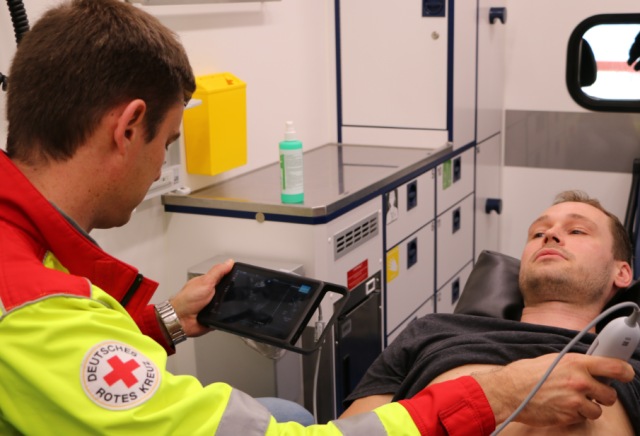
Point-of-care ultrasound (POCUS) is rapidly becoming a crucial tool for emergency medicine in Germany, and it's increasingly common for ambulances and emergency doctor vehicles to be equipped with POCUS systems. Dr. Torsten Müller is the medical head of rescue services for Kassel, Germany, overseeing pre-hospital care functions for a system that currently runs 65 ambulances and a helicopter, as well as six emergency doctors’ cars that have recently been equipped with FUJIFILM Sonosite iViz systems. Dr. Müller also works part-time as an anaesthetist at Klinikum Kassel, one of the region’s hospitals.
Dr. Müller sits down with Sonosite to talk about the must have functions for a point-of-care ultrasound machine, how he views ultrasound education and what he thinks is the future of point-of-care ultrasound.
What are the most commonly used applications for a portable ultrasound machine, in your pre-hospital experience?
Ultimately, you can perform an ultrasound exam on nearly every patient, and get a synopsis of their overall health, regardless of location. We conduct FAST exams for victims of car crashes. We scan the abdomen to look for free fluid or internal bleeding. Cardiac exams are also crucial for us. Lots of patients have cardiovascular disease, so we need to be able to quickly and efficiently check basic cardiac function and valves, as well as assess the lungs to check for pneumothorax, atelectasis, pulmonary edoema, or pleural effusion.
The requirements of an ultrasound system in an emergency setting are different from those of cart-based systems in hospital radiology departments. Dr. Müller told us the five biggest differences between traditional ultrasound and the POCUS systems that he and his team use in the field:
- We need POCUS systems that fit into bags or backpacks. We couldn’t wheel a giant cart out to a car crash, obviously.
- The systems need to start up quickly. We don’t have time to wait for 5 minutes in an emergency.
- Ultrasound systems must be user-friendly. We have to concentrate on the patient’s health, so we can’t be messing around with advanced settings or confusing instructions.
- The machines must be robust enough that they can survive being banged around or occasionally dropped on the ground.
- The ultrasound transducers need to be suitable for our most commonly used exams, like a FAST exam.
Most of the emergency doctors working for the Kassel rescue service are anaesthetists like Dr. Müller. They work in hospitals, and some of them use ultrasound every day in the hospital.
Is it hard for newcomers to pick up the ultrasound skills that are needed to work with portable ultrasound machines?
Ultrasound is a technique that initially requires a bit of practise but, by scanning every patient you see, you can quickly build on your experience. Some of my colleagues are still learning, attending courses to get familiar with the technique and its advantages.
What’s the future of portable ultrasound?
I can already see other situations where it may help us in the future. Regional nerve blocks could replace intravenous pain relief in an emergency setting. You could, for instance, numb just the shoulder nerves in order to reset a dislocated shoulder. The iViz lets you see all the affected nerves and vessels easily. Ten years from you, I expect that all emergency medical cars like ours will be equipped with portable ultrasound systems. The information we get from it is so significant – nobody will want to miss out.
Increase Your Scanning Confidence With Ultrasound Education
We've partnered with clinician educators around the world to produce specialty specific point-of-care ultrasound education resources. Check out all our educational resources on our Education page.


